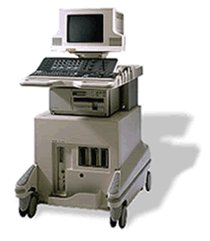Vaginal Ultrasound
To look at the ovaries, uterus, cervix, fallopian tubes, and bladder, we use Vaginal ultrasound. Sometimes referred to as pelvic ultrasound, it is done externally on the lower stomach. These organs show up well because ultrasound devices see soft, liquid filled organs readily. It cannot show bones well.

Because no radiation is involved, there is no known danger to the mother or to a fetus that we know of after 50 years of testing. See ultrasound safety Also known as sonography, it uses high frequency waves that reflect off of tissue and echo back to the transducer to make images in the computer. A monitor reveals the pictures. For more on this please see How it Works. The test can detect multiple fetuses, abnormal signs during pregnancy, and can monitor a babies growth, and heartbeat.

Pelvic ultrasound can be used to detect cancer, cause of unusual menstrual bleeding, pelvic pain, growths such as ovarian cysts, fibroids scars, problems with the bladder, kidney stones, and polyps. You should wear loose clothing and may be asked to wear a hospital gown. You may be asked to drink several glasses of water because a full bladder shows up best.
4D ultrasound
can show blood flow in real time to make sure the arteries and veins are normal and have no aneurysms or blockages. Your doctor will inform you as to what you need to do before a
vaginal ultrasound. Also see transvaginal ultrasound.
Back to ultrasound types
Genesis ultrasound machine Home Page
Medical Disclaimer




